Shelter Programs and Enrichment Ideas
Introduction
Shelter enrichment programs help reduce the stress and boredom of kennel life. While all shelter dogs benefit from enrichment programs, such enrichment activities are especially valuable for long-term residents and “bully-breed” dogs, who tend to deteriorate quickly in kennels.
Without enrichment activities, kenneled dogs may exhibit unwelcome behaviors, such as hyper-arousal, depression, and obsessive/compulsive behaviors.
Dogs and puppies may display behaviors that make adoptions more challenging simply because they are not given the opportunity to chew, be mentally engaged, or interact calmly with humans. This is especially true for canines who arrive at the shelter with behavior challenges.
General, overall enrichment should include:
Exercise – Daily walks and training (controlled and monitored)
Social Interaction – pets, hugs, playing fetch with staff and volunteers, hanging out in the office, sitting with someone who is reading/working
Food Games – using toys such as KONG™, Tug-a-Jug™, etc.
Sensory Stimulation – such as sound (classical music), odor (lavender, spices, and even a bit of bedding from the cat area), and tactile stimulation (brushes to rub against, bedding, and large Boomer Balls)
Below are suggestions for enrichment activities like these. All of this information may be used when training new volunteers or items added to your Wish List.
Adaptil
ADAPTIL Calm On-the-go Collar is a clinically proven solution to calm your dog indoors and outdoors, in situations like loud noises, staying alone, boarding and other fearful situations.
- Brings you and your dog closer by providing constant reassurance to your dog.
- Clinically proven, veterinary used and recommended.
Click link below to learn more.
https://www.adaptil.com/us/Products/ADAPTIL-Calm-On-the-go-Collar
Clicker Train Your Dogs to Show Well
Everyone knows that when people enter the kennel area, the sound can be deafening. And we also know that dogs who come to the front of their kennels and sit nicely have a better chance at being adopted. Give your staff or volunteers a fanny pouch filled with treats and a clicker. Send them to the kennels to walk down the row repeatedly and treat/click for any dog that comes to the front and sits quietly. Eventually, most of the dogs will figure out that when someone comes in they are likely to get treats if they come to the front and sit quietly.
It may take some time to convince a few, but patience and persistence will pay off, plus it’s a fun/rewarding job for volunteers. AND most importantly, it will help teach your dogs self-control and just maybe help them find an adopter. Once the dogs associate the click/treat as a reward, other staff can carry clickers on a belt loop or clip them to the kennels and walls to reward the dogs even if they don’t have a treat.
Create a Normal Room
A “normal room” or a “real-life room” at a shelter is a space with couches, rugs, toys, music, or a television set up to resemble a room in a home. The idea is to provide a comfortable, quiet space where dogs can relax and get away from the shelter environment. An unused room or large closet or even a free-standing shed on the property could be transformed into this comfy room. In addition to furniture, a normal room could include soft dog beds, heat and air conditioning, heated blankets, a window looking out onto a bird feeder, and food puzzles. Once set up, encourage volunteers and staff members to spend time in the room interacting and playing with the dogs.
Dedicate Special Days for Giving Extra Attention to Shelter Dogs
 Allocate special days and times for providing the dogs with extra pampering, and encourage supporters and businesses to get involved. For example, the Caldwell County Animal Shelter, KY highlights “Tasty Tuesdays” and promotes it on social media. In celebration of the special day, the local Sonic restaurant donated pup cups, a supporter baked fall-themed cookies, and proceeds raised from the sale of T-shirts paid for burgers. The shelter posted cute images of the dogs enjoying their special treats. What a wonderful way to provide enrichment for the dogs and engagement with the community.
Allocate special days and times for providing the dogs with extra pampering, and encourage supporters and businesses to get involved. For example, the Caldwell County Animal Shelter, KY highlights “Tasty Tuesdays” and promotes it on social media. In celebration of the special day, the local Sonic restaurant donated pup cups, a supporter baked fall-themed cookies, and proceeds raised from the sale of T-shirts paid for burgers. The shelter posted cute images of the dogs enjoying their special treats. What a wonderful way to provide enrichment for the dogs and engagement with the community.
Go On Outings
If your shelter allows dogs off-site, take a dog to lunch or take one along when you’re on a break or running an errand. The goal is to get them out and about, seeing and experiencing new things, and interacting with the public.
Another idea: Give a couple of dogs some social time by asking a co-worker to walk dogs with you off-site. The first step to providing this type of enrichment is to introduce the dogs carefully and safely, with the awareness that dogs often lack social skills when meeting each other. For more details on how to introduce dogs, read “Helping Shelter Dogs to Meet Each Other Successfully”. Besides providing social opportunities, encouraging dogs to interact politely also helps them become more adoptable.
One shelter will have Wednesday walkabouts. Excursions which take adoptable dogs wearing “Adopt Me” vests out for a walk in places like shopping centers or parks. It’s great for enrichment and also makes adoptable dogs more visible to the public, increasing their chances of adoption. Dog handlers hand out the dogs’ “business cards” to people interested in contacting the shelter for more information.
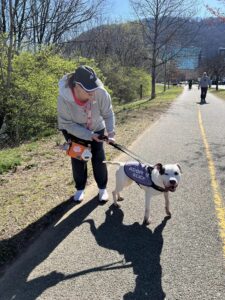 Through the Roanoke Adventure Dogs program, the Regional Animal Care & Protection Center, VA invites members of the community to take dogs out for day-long field trips. The program is a great alternative for those who are unable to adopt, but still want to make a difference in a shelter dog’s life. The shelter removes any barriers by making it easy for participants to get involved. They simply show up at the shelter after 9.30 a.m. and ask to take a dog out on an adventure. At that point the shelter staff or a volunteer:
Through the Roanoke Adventure Dogs program, the Regional Animal Care & Protection Center, VA invites members of the community to take dogs out for day-long field trips. The program is a great alternative for those who are unable to adopt, but still want to make a difference in a shelter dog’s life. The shelter removes any barriers by making it easy for participants to get involved. They simply show up at the shelter after 9.30 a.m. and ask to take a dog out on an adventure. At that point the shelter staff or a volunteer:
• Discusses the adventure plans and the person’s experience level
• Matches the person with a dog that would enjoy the planned adventure
• Makes sure the walking volunteer can handle the dog on a leash
• Goes over the basic rules when spending the day off-site with a shelter dog
• Asks the volunteer to fill out volunteer paperwork
The whole process takes about 15 to 20 minutes and then the volunteer and dog can head off for a day of fun.
At the Animal Harbor Animal Shelter, TN enrichment volunteers take the dogs out on outings to local stores. During a recent visit to Tractor Supply, shelter dog Radley impressed everybody with his “sit,” “stay,” and “down” skills and his excellent leash walking manners. Before leaving the store, he got to choose a dog toy. This was a wonderful enrichment experience for Radley while exposing him to potential adopters.
Give Extra Attention to The Longest Residents
Shelters can reach out to local rescue groups or assign a team of shelter volunteers to focus their attention on the longest residents or hardest-to-place dogs to help make them more adoptable. At the Tazewell County Animal Shelter, VA the Pit Bull Second Chance rescue group works with bully breeds to help get them ready for their forever homes. In addition to working on enrichment activities volunteers who work with the longest residents can help promote these dogs on social media. Maury County Animal Services, TN launched Take a Chance on Me, a trial adoption program focusing on the shelter’s longest residents showing signs of distress. Interested potential adopters can take these dogs home for a trial run before fully committing to adopting. Supporters are asked to share the new program online in the hopes of finding loving homes where struggling shelter pets have the opportunity to relax and become their best selves.
Helen Woodward Animal Center Offers Free Workshops to Shelters
The Helen Woodward Animal Center in San Diego County, CA offers many wonderful programs for shelters and nonprofits. For example, The Business of Saving Lives Conferences and Workshops, which are free to all pet adoption organizations! If shelters cannot afford to send staff to a conference or workshop at the San Diego center, presenters will travel to those shelters to conduct one-day workshops free of charge. Topics covered include, how to raise awareness within your community, ways to increase donations, building a larger volunteer base, and improving on customer service. Shelters can apply online to book a workshop.
Help Dogs with Return-to-Run Resistance
A common scenario at shelters everywhere: You’ve taken a dog out of his kennel for a bit and now it’s time for him to go back in. The dog puts on his brakes, tries to back out of his collar, lies down, and won’t move. You try to pull him and he starts to growl. What to do? Read “Coping with Return-to-Run Resistance” for some ideas on how to help dogs who are resistant to going back into their runs.
You can incentify returning to the kennel by leaving high-value treats or stuffed kongs in kennel for dog to find when they return. If this becomes part of a routine, dogs are happy/eager to go back to their kennel instead of needing to be dragged down. At one shelter, they use a can of whipped cream and squirt a line or circle of it on the clean kennel floor. You could also offer a peanut butter lick board (see separate entry in Resource Guide) as a reward for coming back in willingly. Build this practice into the cleaning routine – last step after kennel is sanitized.
Host Pilates with Pups Classes
Invite a local fitness instructor to the shelter to teach a Pilates with Puppies class. This is a great opportunity for puppies to socialize with people. The workout also becomes a great fundraiser if you charge a small fee. And as an added benefit class participants may just fall in love and adopt a puppy.
Include Dog Walking Opportunities at Adoption Events
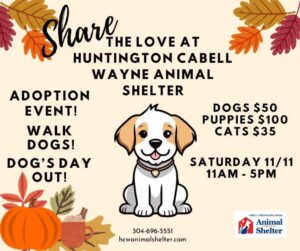 The Huntington Cabell Wayne Animal Shelter, WV invites members of the community to come by the shelter and walk dogs during the shelter’s weekend adoption events. Visitors are encouraged to walk the dogs along the riverfront or take them for pup cups. These outings are a great way to give the dogs a break from the shelter while exposing them to potential adopters.
The Huntington Cabell Wayne Animal Shelter, WV invites members of the community to come by the shelter and walk dogs during the shelter’s weekend adoption events. Visitors are encouraged to walk the dogs along the riverfront or take them for pup cups. These outings are a great way to give the dogs a break from the shelter while exposing them to potential adopters.
Invite Musicians to Perform at the Shelter
Studies show that melodious music can reduce cortisol levels and have a calming effect on animals. It’s especially beneficial in helping anxious shelter animals to relax. Invite volunteers who play classical, soft rock, jazz, or country music on keyboard, string or wind instruments to come to the shelter and play for the animals. Shelters can also register with the nonprofit Wild Tunes by Yuvi, a group of dedicated and talented musicians who are committed to enriching the lives of shelter animals through music. The organization will work to match shelters with local music enthusiasts interested in volunteering.
Keep a Treat Bucket Handy
Keeping a bucket full of treats handy is a good way to reinforce good behavior in dogs. A treat bucket is a nice way to help enforce the training rules, while also involving everyone (staff, volunteers, the public) in the training process. And when prospective adopters come to see them, the dogs will sit politely when the people approach.
Some examples–Have a bucket attached to the front of the kennel that holds the treats and has a sign saying, “Please help train me. Only give me a treat if all four of my feet are on the ground.” This helps train dogs not to jump up on people. The treat bucket is available all the time, for staff, volunteers and the public to use.
You can also create ice-block treat buckets for the dogs to enjoy when the weather is warm. Put various items, such as toys and some treats, in a bucket and fill it with water and freeze the whole thing. A dog can be occupied for quite a while as he licks the ice to get at the toys and treats.
Launch a Dog Day Out Program
In 2023, VCA Charities launched a Dog Day Out Field Trip Program to help reduce kennel stress, increase community volunteerism, and help find homes for shelter dogs. According to the nonprofit for busy shelters that are at full capacity, Dog Day Out programs are low-risk, easy to implement, and can have a huge impact.
Volunteers who take dogs on field trips become advocates for the animal and programs that enable enrichment through public support. Since launching the program, VCA Charities has partnered and supported 20 of the largest U.S. based shelters with a combined intake of more than 325,000 pets annually.
Shelters can visit the Dog Day Out Field Trip Program page to download a Dog Day Out Starter Guide and to sign up to attend an in-person training on launching this program.
Offer a Pack Walk Along with a Picnic in the Park
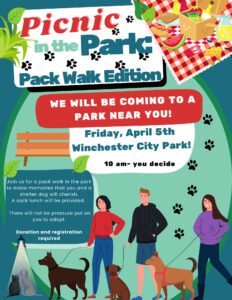 The Animal Harbor Shelter, TN recently added a Picnic in the Park: Pack Walk Edition to its Canine Enrichment Program. Participants are asked to complete an online Pack Walk Registration form and to make a donation to the shelter. Shelter staff bring the dogs to the park and registered volunteers simply show up to walk, socialize, and bond with their chosen dogs. The shelter also provides the picnic food. The goal of the program is to provide enrichment for the dogs outside of the shelter environment.
The Animal Harbor Shelter, TN recently added a Picnic in the Park: Pack Walk Edition to its Canine Enrichment Program. Participants are asked to complete an online Pack Walk Registration form and to make a donation to the shelter. Shelter staff bring the dogs to the park and registered volunteers simply show up to walk, socialize, and bond with their chosen dogs. The shelter also provides the picnic food. The goal of the program is to provide enrichment for the dogs outside of the shelter environment.
Offer a PAWS for a Break Program
A PAWS For a Break program makes a terrific addition to any shelter. At the City of Nashville, GA Animal Shelter supporters are invited to take dogs home for short breaks. They are encouraged to work on training, pamper the pups with doggy ice cream treats, or go for hikes. According to the shelter, this program provides the perfect opportunity for potential adopters to get to know shelter dogs before making a lifelong commitment to adopting. The program also allows those who love dogs but can’t have them to get their puppy time in!
Offer a Variety of Smells and Sounds
As with people, soothing smells and sounds can help dogs relax. For stress relief, introduce aromatherapy–such as lavender, chamomile, valerian, or dog-appeasing pheromones (DAP). You can get vent system aromatherapy or even plug-ins for the shelter. DAP is a spray or plugin that provides an effective way to control and manage unwanted canine behavior associated with fear and/or stress. Try different types of aromas; some dogs have favorites. Also, try playing some light classical music CDs or recorded sounds of ocean waves or rain. Again, experiment with different sounds to see what works best.
Organize Puppy Yoga Classes
Letting shelter puppies loose in a yoga class is great fun for the pups and the students. The classes can be held at the shelter or in a local park with an admission fee or suggested donation to help raise funds for the shelter. This is another great way to socialize the pups while giving them a break from the shelter. It’s also a wonderful marketing tool as images of the pups hanging out with yoga students can be posted on social media. Many of the puppies might even find their forever homes among the students.
Partner with Training Experts
Training shelter dogs doesn’t just provide enrichment it also improves the chances of those dogs finding forever homes. Following are some organizations that specialize in offering training and behavior modification methods to staff and volunteers at shelters and rescues:
Bound Angels Shelter Rescue
Bound Angels Shelter Rescue program provides a unique service to shelters, humane societies, and rescue organizations that helps save the lives of countless shelter pets. The program offers logical solutions and life-saving tools, most available free of charge both online and via hosted training workshops. Bound Angels Shelter Rescue programs range from online training, books, educational and dissemination campaigns, to hands-on canine behavior training and behavior assessments. Visit online to review testimonials from shelters and humane societies that had success with Bound Angels training programs and for information on Bound Angel University.
Dogs Playing for Life
Dogs Playing for Life has served hundreds of thousands of dogs in shelters through playgroup seminars and enrichment programs. By helping shelters improve the quality of life for their dogs, more dogs will be adopted and fewer will fall through the cracks. Dogs Playing for Life offers on-site training, training at their facilities, and also free online webinars.
Fear Free Shelter Program
The Fear Free Shelter Program aims to decrease stress levels for shelter animals by educating staff and volunteers. For example, after completing the Fear Free training program staff at Moore County Animal Services, NC no longer allow the public to tour the kennels because it is too stressful for the dogs. Instead, they introduce the dogs to potential adopters outside the kennel environment. The Fear Free Shelter Program is free for shelter and animal welfare staff and volunteers.
From Kennels To Homes
The mission of the nonprofit From Kennels To Homes is to provide training and behavior modification to shelters and rescues for dogs that have been labeled “unadoptable” due to behavior issues. The organization’s mission objectives include:
• Educating shelter staff on dog behavior and interaction
• Developing an Education program and solutions to help dogs with behavior issues
• Educating shelter staff on proper and safe dog introductions
• Establishing shelter dog play groups
• Training shelter staff on how to help dogs who have been mislabeled “aggressive” due to kennel behavior
From Kennels To Homes actively seeks sponsors to make monetary donations making it affordable for rescues and shelters to afford training and behavioral help for dogs deemed unadoptable. Shelters needing help can reach out to the organization via an online form or by calling 561-360-2200.
GoodPup Shelter Partnerships and Programs Initiative
GoodPup is a virtual positive reinforcement dog training company that partners with over 900 shelters and rescues across the United States and Canada. The training company provides support to new adopters helping set dogs up for success in their new homes. The GoodPup Shelter Partnerships and Programs initiative includes:
- The GoodPup Shelter Affiliate Program – Through the shelter affiliate program, shelter partner clients get one free week of training on the GoodPup platform plus a lifetime discount for any additional classes. GoodPup will send donations to shelter partners for each adopter or foster caretaker who becomes a paying customer of the training company. This program is free for shelters.
- GoodPup’s Webinar Series – Shelter partners have free access to presentations and panel discussions from certified training experts covering training, behavior, and other topics relevant to shelter animals.
- The GoodPup Advantage Program – Shelter partners can offer pre-paid training scholarships to support adopters, fosters, and dog owners seeking assistance with training. Scholarship recipients receive a custom training plan and have access to GoodPup’s Behavior Team when advanced support is needed. Shelters can choose from several discounted pricing options.
To learn more about becoming a shelter partner, submit an online form or email shelters@goodup.com.
Shelter Playgroup Alliance
The mission of the Shelter Playgroup Alliance (SPA) is to work with shelters to:
- Empower shelter dogs through choice
- Educate staff and volunteers on managing dog interactions
- Implement enrichment programs and playgroups
The SPA’s no-cost educational resources on implementing shelter enrichment and managing inter-dog interactions, including play include written guidelines, a newsletter, 3-day in-person workshops hosted by shelters nationwide, and 2-day virtual workshops.
Partner with a Local College or University
Whether inviting students to volunteer at the shelter or taking dogs onto local campuses, partnerships with colleges and universities offer wonderful enrichment opportunities. A good example is the partnership between Anson County Animal Shelter, NC, and Wingate University. Students participate in Volunteer Day at the shelter and dogs visit the campus to engage in Dog Yoga classes and also visit during Dog Day Finals when the dogs provide stress relief for students. These trips provide much-needed exposure for the dogs while giving them a break from the shelter environment. Students also help to promote the dogs, which can help them find their forever homes.
Partner with a Running Club
Taking shelter dogs out for a run is a great way to help them burn off pent-up energy while getting a break from the shelter environment. Shelters can reach out to the local high school coach to enquire about creating a partnership between the school’s running teams and shelter dogs. In California, the annual Fun Run with Lodi Animal Services features cross-country runners from Tokay High School and dogs from the local shelter. The fun run features a 5K out-and-back course in a local park. The larger shelter dogs complete the full 3.1 miles, while the smaller dogs walk the perimeter of the park. Before the run, the high school boys’ and girls’ cross-country teams visit the shelter to meet the dogs and practice running with them. By the end of the 5K, many runners have formed strong bonds with their four-legged partners. Some end up adopting the dogs or the dogs are adopted by members of the public who met them before or after the marathon.
Play Calming Music
Research has shown that calming music can help shelter dogs relax in what can often be a very stressful environment. Auditory enrichment also helps to mask shelter sounds of doors or gates opening and closing that can get dogs worked up. Many shelters add the “Through a Dog’s Ear” music CD series to their Amazon Wish Lists. Through social media they let their supporters know the music’s positive impact on shelter dogs’ lives as they wait to go to their forever homes.
Play Hide ‘N Seek
Note: To keep dogs safe, this enrichment activity should not be used in areas containing, or accessible to, more than one dog. If dogs are housed in groups, each dog should be given a private space when playing hide-and-seek.
It’s not just kids who love this game — dogs love it, too! Keep dogs mentally and physically active by making them think and search for their treats. Some suggestions:
- Bury toys or treats in a sand box.
- Place toys or treats in ladles and hang from trees.
- Place toys or treats in logs or other hiding places in play yards.
Provide a Variety of Toys
Note: To keep dogs safe, this enrichment activity should not be used in areas containing, or accessible to, more than one dog. If dogs are housed in groups, each dog should be given a private space to play with toys.
Dogs enjoy having toys or something to play with. Just make sure that easily destroyed toys, such as rope toys or stuffed toys, are never left with a dog who is unsupervised. Best Friends recommends Other Cuz Balls (made by JW Pet Company) because they are practically indestructible and have no appendages that dogs can chew off and swallow.
Lick toys. Licking helps soothe anxious dogs and pass the time. One inexpensive lick toy is a ‘peanut butter board’. Purchase plastic cutting boards (with a cut out handle), smear with peanut butter, and hang on a dog’s front fence with a carabiner clip or zip tie(in the center away from other dogs). This is a great project for volunteers or a scout troop to take on. Cutting boards can be easily washed in the dishwasher. Supplies: plastic cutting boards from the dollar store or Walmart, a large tub of peanut butter (Costco is a great source), spatula for smearing peanut butter, carabiner clip (or zip ties).
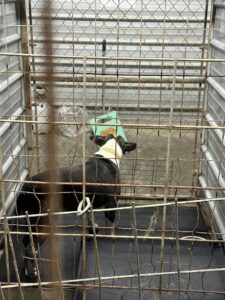
Food-dispensing toys. Dispensing toys are great for mental stimulation and they increase the time during the day when a dog has meaningful activities to engage in. You put treats or meals in the toy and the dog has to figure out how to get the food out. Most dogs are highly motivated, but be sure to start with easier toys that the dog can experience success with; too difficult a puzzle can increase frustration and promote loss of interest. As the dog’s skills improve, he will enjoy more challenging toys.
Try Treat Stiks, Busy Dog Balls or Buster Cubes.
Premier Busy Buddy makes several types of treat-dispensing toys, available at pet supply stores.
Kongs are durable rubber enrichment toys that can be stuffed with moistened dry dog food or peanut butter or spray cheese. For more information, visit their website at www.kongcompany.com. The Animal Rescue Corps, DC uses Wishlist Wednesdays to highlight how much the dogs enjoy their stuffed Kongs and to ask for donations of peanut so they can continue to stuff these popular chew toys.
Lots of homemade versions of treat-dispensing toys can be found on Pinterest or Google.
Chew toys. Dogs love to chew, so giving them appropriate things to chew is a great enrichment activity.
Nylabone makes a variety of chew toys and interactive toys for dogs, providing them with hours of fun. Check out their products at www.nylabone.com. Nylabone and most other manufacturers recommend supervision for many of their products.
Plastic water bottle/sock toy. This is another easy, inexpensive toy that volunteers or scout troops or school classes can make. Stuff a clean, dry water bottle (with plastic ring and top removed) inside a clean sock and know the sock. The toys provide a satisfying crunching sound and can be thrown out (or the bottle replaces) when they are worn out. To make it more fun/educational for children making the toys, have them use a washable marker to decorate the sock with inspiring messages for the dogs.
Ice-block toys. These “toys” will keep dogs occupied for hours and are a nice treat on a hot day. They are easy to make: Place a few toys in a bucket, fill the bucket with water, and freeze it. Another idea for a frozen treat: Freeze chicken or beef broth in popsicle molds or drinking cups. Be sure to always supervise the dog enjoying the treat.
Recyclables Can Be Transformed into Enrichment Toys
Reaching out to followers to ask for recyclables that can be transformed into enrichment toys for pets is a great way to encourage people to support shelter animals. For example, the SPCA of Bradley County, TN posted on social media letting people know that their trash could be the shelter’s treasure. The shelter offered a list of items they could use to provide enrichment for the animals at the shelter. Those included:
• Empty tissue boxes
• Cardboard egg cartons
• Paper towel and toilet paper rolls
• Mini solo cups
• Bottle caps
• Paper lunch bags
Along with requesting recyclables, this is a good time to ask for donations of items needed to make enrichment toys attractive for pets. For example, peanut butter, dog and cat treats, and cat nip. Be sure to remind followers that enrichment toys are vital to the mental well-being of shelter animals while they wait for their new homes.
R&R Program
Through the Read and Relax (R&R) program, a volunteer enters a dog’s kennel, sits down on a chair, and reads aloud to the dog for 30 minutes. R&R helps decrease the arousal and stress levels of dogs on the adoption floor as adopters pass through.
Set Up Group Play Sessions
Group play is a great way to get the dogs exercised and keep them mentally happy and healthy. A half-hour of group play is the equivalent of a two-hour walk. As with tandem walks, you’ll need to introduce the dogs carefully to prevent any problems. Recording playgroups and showing them live on social media is a great way to introduce dogs to potential adopters and describe their personalities as they interact with other dogs.
Before participating in group play sessions, you should learn how to monitor play groups and gather the tools you’ll need for the play sessions. You will need to learn more about dog body language to better decide which dogs are ready for play groups. Dogs Playing for Life can provide in person training, but they also provide free online training as well. Always monitor a group play session closely and be sure to take into consideration the reproductive status of the dogs and also vaccination status to avoid passing contagions.
To see the difference regular play sessions can make in the lives of shelter dogs, check out how calm and quiet the dogs at the Marion County Animal Shelter were during a recent WWLDO shelter tour visit.
Sponsor Weekly Pack Walks or Hikes
Weekly pack walks or hikes are a great way to get dogs out of the shelter and into the community. For example, through its Waggin’ Walkers program, the Yancey Humane Society, NC invites walkers and hikers to give shelter dogs much-needed exercise. The pack walks are held on Wednesdays and Sundays. Inviting adopters to join these outings with their newly-adopted dogs is a great way to keep them connected to the shelter. Choose experienced dog handlers to coordinate the walks or hikes and match volunteers up with appropriate dogs for their skill levels. Pack walks and hikes are fun activities for dogs and people, and a great way to keep the community and volunteers engaged with the shelter.
Take Shelter Cats Out in Strollers
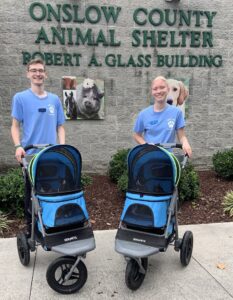 While shelter dogs often benefit from going on walks or outings with volunteers, shelter cats tend to spend most of their time confined indoors at the shelter. A research study at the Virginia-Maryland College of Veterinary Medicine found that shelter cats may benefit from being taken out in strollers. This activity gives them a break from the shelter environment and an opportunity to safely enjoy the sights and smells of the great outdoors. Stroller adventures for kittens are among the many volunteer opportunities at Onslow County Animal Services, NC.
While shelter dogs often benefit from going on walks or outings with volunteers, shelter cats tend to spend most of their time confined indoors at the shelter. A research study at the Virginia-Maryland College of Veterinary Medicine found that shelter cats may benefit from being taken out in strollers. This activity gives them a break from the shelter environment and an opportunity to safely enjoy the sights and smells of the great outdoors. Stroller adventures for kittens are among the many volunteer opportunities at Onslow County Animal Services, NC.
Teach Basic Manners and Life Skills
Some shelter dogs come from backgrounds where they didn’t have the opportunity to learn social skills. Teaching basic manners and life skills provides mental stimulation and helps dogs become more adoptable. All dogs should have skills such as these:
- Walking well on a leash
- Not jumping up to greet people
- Sit, stay, leave it and come
- Name recognition
You could also try teaching some silly tricks, like how to do a high-five. When teaching a dog any new skill, remember to make it fun for the dog. Be patient, stay positive, and reward success with plenty of praise and treats.
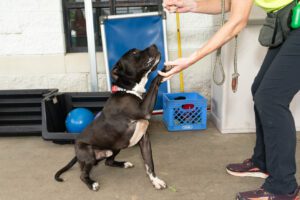
Shelter staff and volunteers can teach dogs these skills on an individual, informal basis or you could start a shelter manners or canine enrichment program with staff and volunteers working with dogs under the guidance of a professional trainer. The class could be held regularly — once a week, perhaps — with volunteers or staff members each responsible for bringing a dog to the class. The added advantage of a group manners class is that it helps shelter dogs develop good relationships with both people and dogs.
Another great way to provide training is to invite students from veterinary colleges, dog training academies, or veterinarian technician students to work with dogs under the supervision of a professional positive reinforcement trainer. At Redland Rock Pit Abandoned Dog Project student trainers work with the shelter dogs to earn AKC S.T.A.R Puppy certification. The program provides great enrichment and engagement for the dogs while helping make them more attractive to potential adopters
Think Outside the Box
The number of ways that you can enhance shelter dogs’ well-being is limited only by your imagination!
Shy/Fearful/Feral Dogs
We are working on this section, as we know there is a great need. Meanwhile, Best Friends has some good infromation on helping very shy dogs: “Feral Dogs and Shy Dogs: How to Help Them”.
Click Links for More Resources
• Resource Guide
• Advocacy
• Community Outreach & Education
• Fostering
• Fundraising
• General Resources & Programs
• Grants
• Holidays – Shelter & Animal-Related
• Kids 4 Paws
• Marketing Your Dogs
• Shelter Programs & Enrichment Ideas
• Volunteer Programs & Practices
• Other Useful Shelter/Rescue Information